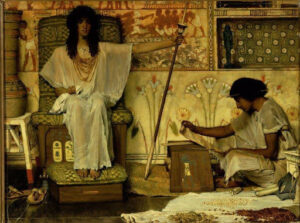From Folk Tales, History
Parasha Miketz Drash by Robert J. Littman
The Torah is a sacred history of the Jewish people from the patriarch Abraham down through the death of Moses. It is a family history of the descendants of Abraham that recounts the encounter of the children of Israel with the divine during this period. It is the story of a patrilineal kinship group, that is a descent of all members from a common ancestor, Abraham, either through birth or adoption. As such, it follows a similar pattern of sacred histories of many cultures over many eras and geographical locations. The sacred history continues down another 1200 years in the Prophets, and Writings. Sacred history is true, but not always factual. When we get to the later periods of Jewish history, such as the story of the Maccabees, we can often see the seams where sacred history developed. One example is the “miracle” of Hanukkah. The Maccabees led a revolt against the Greek monarch, Antiochus Epiphanes, ruler of the Seleucid kingdom. In 164 BCE Judah Maccabee reconquered Jerusalem and purified the Temple. The Talmud and the Megillah of Antiochus, written at least 500 years after the event, tell us that the Maccabees found pure oil which would only last for one day, but miraculously, the oil lasted for eight days. However, when we read the Book of Maccabees, likely written by a Maccabean court historian in the late 2nd century BCE, we find the story of the purification of the Temple, but no mention of the story of the oil lasting eight days. The “miracle” of 8 days of oil was made up hundreds of years later to give a religious interpretation to the festival of Hanukkah, which had hitherto been a celebration of the independence day of the Maccabees. For the Maccabees the real miracle of Hanukkah was that a small rebel force had defeated a mighty empire and established an independent kingdom. For Talmudic Judaism a military victory was not the miracle, but the miracle was a new story, that the purified oil lasted eight days.
So, if we look at the story of Joseph, was Joseph a real figure, and if so, are the stories about him based in fact or folklore? There have been many attempts to place Joseph in Egyptian history. But in fact, there is no mention of Joseph, nothing in Egyptian sources that indicate he ever lived. Many of the elements of the story are drawn from folk tales that are found in many ages and places. The story of the wife trying to seduce someone in the household, and then rejected, is found in many cultures. We find almost the same story in Greek myth. Phaedra, the wife of King Theseus, tried to seduce her stepson, Hippolytus, but was rebuffed. In fear of discovery, she wrongly accused Hippolytus of trying to seduce her. Likewise, in ancient Egyptian folklore, the wife of Anpu tries to seduce Anpu’s brother, Bata, and when rebuffed, accuses Bata of trying to seduce her. The story of the Seven Year famine may be based on a historical occurrence of famine. A stone stele, inscribed on Sehel island in the Nile near Aswan, Egypt, describes a seven year drought and famine in the reign of the pharaoh Djoser around 2650 BCE because the Nile failed to flood. Djoser asks the priest, Imhotep, for help in solving the famine. Imhotep travels to Hermopolis to consult the god Khnum. Imhotep falls asleep and is advised in a dream by the god Khnum. Imhotep reports this visitation of the god to Djoser, who restores the temple of Khnum, and Djoser grants the temple of Khnum power over the region around Aswan, and a share of all imports from Nubia. Imhotep rises to be one of the most important people in Egypt after Djoser.
The story of Joseph is also a connective device to explain the double origins of the Israelites, one branch the descendants of Abraham, and the other the Israelites living in Egypt with Moses. Joseph’s story tells how the Israelites came to Egypt, and how Moses was really a descendant of Abraham. Many elements of the Joseph story reflect actual Egyptian material: accounts of mummification of Jacob, mummification of Joseph, marriage with Egyptian women. Various attempts have been made to identify Joseph with historical Egyptians. One, is that he is really Yuya, a probable Semite, who was the grandfather of Tutankamun. While this identification is improbable, we do know of a Semite, named Aper-El who rose to become an official of the pharaoh Amenhotep III (1400-1353 BCE). The mummy and tomb of Aper-El, whose name probably means, “servant of El,” survive.
If the story of Joseph simply is a folk-tale, how do we treat it in the context of sacred history? It does not matter whether the story of Joseph, or the other stories are true. The stories explain who the Jewish people are and their encounter with the divine. The Jewish people existed in the late 2nd millennium BCE, and we are members of their kinship group, whether by descent or adoption. What is important is the message of that encounter, the basis of our laws and our history. Think of the events like a painting- the artist completes the painting which is his vision of events. By its very nature it is an interpretation of reality. Subsequent viewers participate in the artist’s vision of reality but can bring their own biases and life experiences to draw out of the picture their own meaning. That is why every generation interprets the sacred text and history in line with their own societal biases and structures. It is a divine revelation through our interpretation of it and the ability of each age to find the divine in the narrative. The artist’s original interpretation is superseded by that of every viewer.

Sir Lawrence Alma-Tadema Joseph, Overseer of Pharaoh’s Granaries (1874)